Lamkhaga is a 90-kilometer trail that passes through the remote valleys of Kinnaur (Lower & Upper Baspa) and Garhwal. The ~5300 meters high altitude pass is a classic Himalayan crossover — between Chitkul and Gangotri.
The Pass curtails a 480 km road distance between Chitkul village of Kinnaur & Harsil village of Gangotri valley to just about 90 km. It was first crossed by Marco Pallis in 1933. The trek is better known as Chitkul to Gangotri or Harsil to Chitkul trek.
About Lamkhaga Pass ⛰
There are two entry routes from Chitkul village of Baspa valley to the Kyarkoti valley of Harsil. One on the south-western side of Lamkhaga is Chotakhaga pass, which is slightly lower in altitude than Lamkhaga pass.
It is called Chotakhaga — an acronym for a shorter pass. ‘Chota‘ for shorter & ‘Khaga’ translates to pass. It offers a shorter (route cut short by around 10 km) but grueling climb and strenuous descending traverse to Harsil. The route from Chotakhaga meets the Lamkhaga trail at the upper Kyarkoti valley.
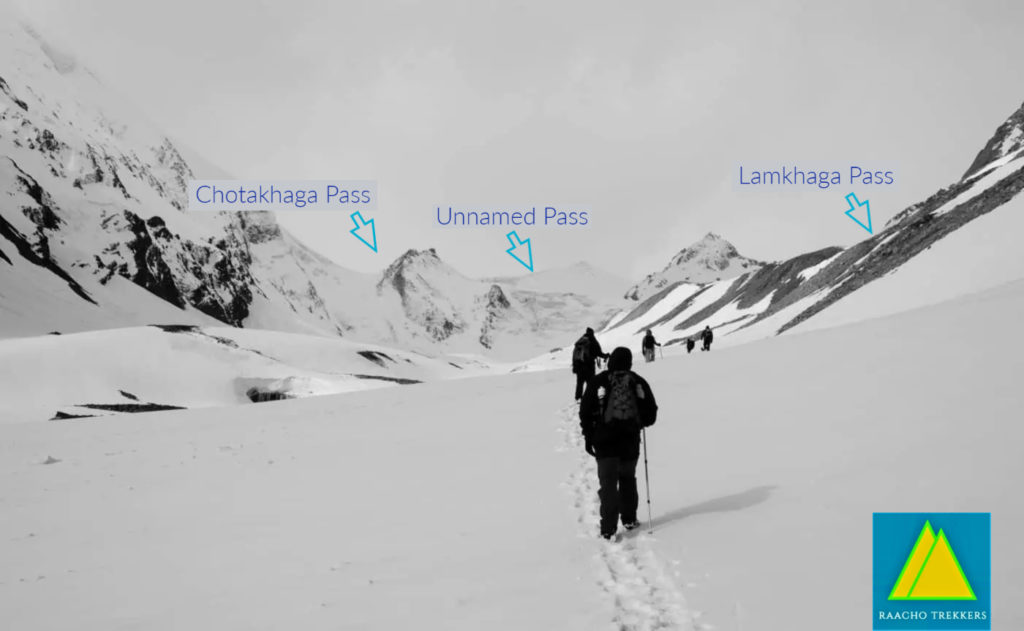
Lamkhaga, on the other hand, is a long traverse. Lamkhaga here is an acronym for a long route pass. Lam for long and Khaga for Pass. It’s a 5300m high altitude mountain pass with a corniced ridge and near-vertical slopes on both sides.
The pass is surrounded by Cirques and vast snowfields of Baspa glacier and Jalandhari Gad glacier of Uttarakhand. Jalandhari Gad is a right-side tributary of the Bhagirathi River. Lamkhaga, Nela pass, and Chunsa Khaga pass lie on the same ridge.
Lamkhaga pass forms the drainage divide between Jalandhari Gad ― a tributary of Bhagirathi river ― and Baspa River (left bank tributary of the Satluj river). In this context, Lamkhaga is a water parting ridge between Sutlej (or Satluj) river and Ganga River as Bhagirathi meets Ganga and Sutlej meets Indus River.
Lamkhaga and Chotakhaga (Nela pass) descend into the Kyarkoti valley along the Jalandhri Gad river, whereas the Chunsa Khaga pass descends into the Nelang (also pronounced as Nelong) valley along Chor Gad river near the Indo-Tibet border. Owing to border proximity, a trekking permit is needed (it is mandatory) before heading out for trekking or climbing in such restricted areas.
Till the Spring months (April and early May), the valleys of upper Baspa of Kinnaur & Kyarkoti of Harsil stay thickly carpeted with snow and traversing the Baspa and Jalandhri Gad snowfields get notoriously difficult.
Lamkhaga pass trek is doable from the 3rd or 4th week of May month to the month of September.
During the springtime (late April and May months), trekkers are welcomed by blooming pink rhododendron flowers in Jalandhari Gad and Kyarkoti valley of Harsil — a magical experience that should be added to the bucket list.
Which Lamkhaga pass?
The trek leading up to the Harsil in Gangotri Valley is one of the most popular treks starting from Chitkul. It is known by various names, which can be a little confusing.
To be clear, these:
- Chitkul-Gangotri Trek
- Chitkul Trek
- Chitkul-Harsil trek
- Harsil-Chitkul trek
…are all the same!
How Difficult is Lamkhaga Pass Trek?
Difficulty
Though the difficulty level is an indefinite attribute, the following factors qualify Lamkhaga Pass for the most difficult trek in Himachal Pradesh.
- Near vertical incline from Lamkhaga snowfields to the pass summit.
- Long stretches of the glaciated route.
- Boulder-strewn zones
- More than 90km long trail
- Crossing high flowing ice-cold waters of Baspa River.
The rains during monsoon season in Harsil & Kyarkoti valley often cause unwanted delays in reaching the next campsite. Harsil is famous for Wilson’s Cottage that was built in 1864. Gangotri is a short drive from Harsil, while Chitkul is the last village in the Sangla valley. The Lamkhaga pass trek offers a panorama of diverse landscapes that includes:
- Ranikanda meadows.
- Boulder-strewn terrain.
- Baspa glacier and glacial moraine zone.
- Baspa Glacier Snout & Outwash plain.
- Chunsakhago (otherwise known as Chunsakhaga) glacier – The origin Baspa River.
- Wildflower-laden alpine pastures of Ranikanda and Kyarkoti.
- Small glacial tarns in Upper Kyarkoti of Harsil valley.
Our team first explored the Lamkhaga route in June 2014.
Pass Experiences
₹ What does Lamkhaga Pass Trek Cost?
The cost of Lamkhaga Pass trek starts from 30,000 INR. Variables like group size, pick-up location (Chandigarh/Shimla), departure date (pre-monsoon in May/June or post monsoon in September), and add-ons (like backpack offloading, accommodation before and after the trek and drop-off place (Dehradun/Delhi) will determine the final price.
Our fixed departures for 2024 are scheduled for September 1 and 15, 2024. We can arrange a customized trek if the dates are not suiting your plan.
Trek Cost Includes
Inclusions
- All arrangements for overnight stays during the trip.
- Camping & Climbing gear.
- All food expenses.
- Food will usually consist of morning breakfast, lunch, evening high tea, and dinner.
- All food will be vegetarian.
- Trained & certified guides who have long experience in handling emergencies.
- Local guides and support staff with an in-depth understanding of the region.
- Porters will carry your backpack.
- Inner line permits and arrangements en route will be arranged by the operator.
- All stays and lodging on a twin sharing basis shall be provided.
⚡ Lamkhaga Pass Trek 2024 Rundown
Rundown
| Region | Kinnaur-Garhwal Himalayas |
| Trip Span | 10 days and 9 nights |
| Difficulty Level | Challenging |
| Apex Altitude | ~ 5300m (Lamkhaga pass) |
| Best Time | Between May to September |
| Trail Length | ~ 90 km |
| Highlights | Baspa valley, Chitkul village, Ranikanda meadows, Chunsakhago/ Chunsakhaga glacier, Baspa glacier snout, Lamkhaga pass snowfields, pink rhododendron forest of Kyarkoti, Kyarkoti meadows |
| Departure Date | September 1, 2024 |
| Group Size | 10 |
| Starts From | Chitkul village |
| End At | Harsil |
| Activity | Camping, walking, hiking, climbing, glacier crossing, streams and river crossing, boulders and scree slope crossing |
⚐ Brief Itinerary of Lamkhaga Pass
Brief itinerary
- Day 1: Shimla – Chitkul village (altitude 3400 m, drivetime ~8hrs)
- Day 2: Chitkul–Nagasti–Rani Kanda (altitude 3700 m and ~10 km trek distance)
- Day 3: Acclimatization day
- Day 4: Rani Kanda – Dumti (alt 4050m ~10km trek)
- Day 5: Dumti – Gundar (alt 4450m ~ 15km trek)
- Day 6: Gundar – Lamkhaga Base camp 1 (altitude 4600 and ~9 km trek)
- Day 7: Lamkhaga Pass Base camp 1 to Base camp 2 (altitude 5000 and ~6 km trek distance)
- Day 8: BC 2 – Lamkhaga Pass(5300m) – BC 3 (Harsil side)
- Day 9 Basecamp 3 – Kyarkoti (altitude, 3820 m and ~16 km trek)
- Day 10 Kyarkoti – Harsil (altitude 2700 m and ~14 km trek)
Detailed Itinerary of Lamkhaga Trek
Expand Itinerary
This 10-day Lamkhaga trek itinerary commences from the beautiful village of Chitkul in Sangla or Baspa valley of Kinnaur, Himachal and ends at Harsil (Gangotri region, Uttarakhand) through some remote regions, usually not accessible for the civilians.
Day 01: Shimla – Chitkul
Reception at Shimla, have breakfast and drive to Chitkul via Kufri and Narkanda. Reach Sangla village by late afternoon. Explore the Baspa valley and have dinner at Chitkul. Overnight stay in Chitkul in guest house/ village homestay.
Day 02: Chitkul – Nagasthi – Rani Kanda
Chitkul is the last village in Baspa valley and is located on the true right bank of the river. The valley of Sangla is 26 km from Chitkul and is very beautiful and one of the best in Kinnaur. We start the trek from Chitkul and trek up to Rani Kanda. Dinner and overnight stay in tents in Rani Kanda.
Day 03: Acclimatization day
Today we take rest in Rani Kanda and acclimatize ourselves. We can relax and explore the surroundings.
Day 04: Rani Kanda – Dumti
Today we trek through and cascading waterfalls and flowery meadows to reach Dumti. Dinner and overnight stay in tents in Dumti.
Day 05: Dumti – Gundar
Start the day from Dumti and trek up to Gundar. We follow the Baspa River all along and cross several small streams along the way to reach Gundar.
Day 06: Gundar – Lamkhaga Pass Base Camp
It could be a tough day depending upon the snow conditions and so an early start is recommended. The climb is steep and may require some technical gear. Dinner and overnight stay in tents at the base camp.
Day 07: Lamkhaga Pass Base Camp – Base camp II (Kinnaur)
Today we trek from the base camp to the base camp II on the Kinnaur side. The climb is steep and on snow. We start early because at times it might take longer than expected.
Day 08: Base camp II (Kinnaur) – Lamkhaga Pass – Base camp III (Gangotri)
Today we start our final ascent to the Lamkhaga Pass and we cross the mountain pass and get over to the base camp on the Gangotri side. The climb is steep and might require technical gear.
Day 09: Base camp III (Gangotri) – Kyorkati
Today we descend from the base camp to Kyorkati at the mouth of the glacier which is a meadow. We pitch our tents here and camp for the night.
Day 10: Kyorkati – Harsil
The final leg of the trek is through very beautiful and through thick forests, numerous waterfalls, and unnamed streams. We finally reach Harsil and rest for the night in the village homestays or tents. The next morning we depart for Uttarkashi.
Lamkhaga Pass Intermediate Campsite (4650 Mtr) – Kinnaur (Himachal Pradesh)
Lamkhaga Pass Intermediate campsite is a very high-altitude campsite with views of 3 passes of Jalandhari Gad Valley – Chhotkhaga Pass, Dudhiyan Pass & Lamkhaga Pass.
Are you a match for Lamkhaga Trek?
You must have done at least one high altitude trek before. Those who do not have requisite trek experience of high-altitude passes should not apply.
You must be physically fit to do a 9-day Himalayan trek. The Lamkhaga pass trek leads you up to 17,390 feet high pass of Lamkhaga and through a long expanse of snowfields of Jalandhari gad and Baspa glacier. At this altitude the air is thin, and the rigors of the mountain can grind you down. You must give yourself enough time to prepare yourself for the trek.
NOTE: Trekkers are required to bring a medical certificate deeming them fit for high-altitude trekking at the start of the trek.
Backpack carrying: A porter will carry your backpack, please do not bring extra items but only the essentials needed for high altitude trek. Besides detailed planning, taking care of all the logistics, food, and good equipment, packing a backpack efficiently and carrying essential things play a key role in the success of an expedition.
Bare Essentials for Lamkhaga Trek
Essentials
- A pair of good quality waterproof trekking boots.
- Three pairs of socks.
- Two pairs of waterproof hiking pants.
- One pair of shorts
- Two pairs of fleece jumpers.
- Two pairs of thermal tops and bottoms
- One down jacket.
- Headgear (1 beanie/skull cap, 1 buff, and 1 trekking cap).
- A pair of thick gloves
- Personal hygiene essentials (alcohol-based gel hand sanitizer, soap, towels, toilet papers, baby wipes, etc.)
- UV-block sunglasses.
- First aid kit.
- A water purifier and filtration bottle.
Lamkhaga Pass Route Maps
Maps
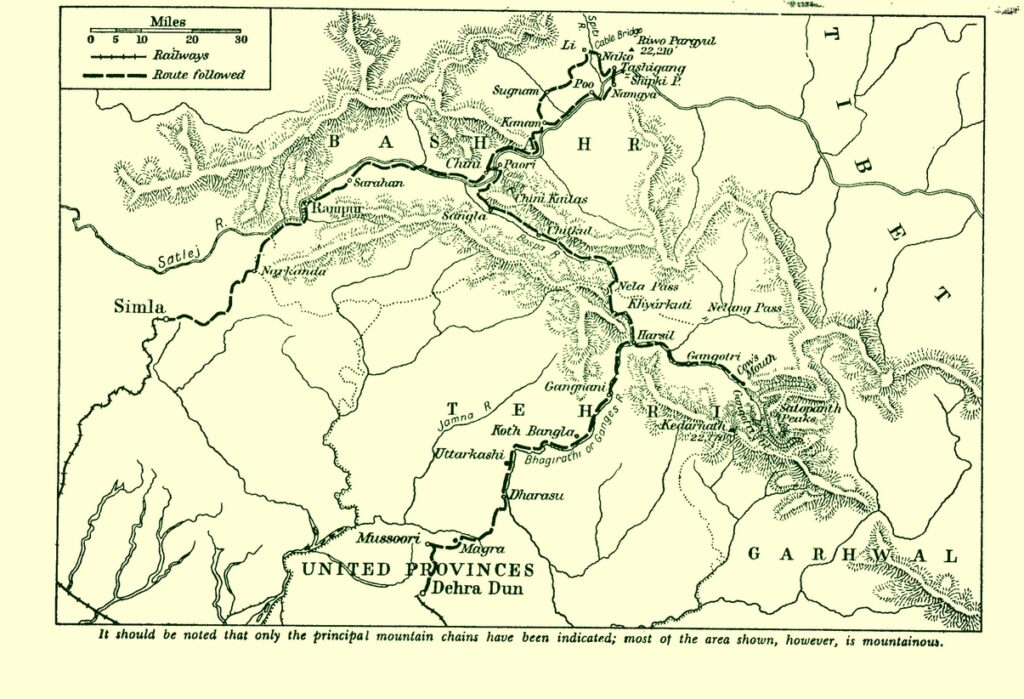
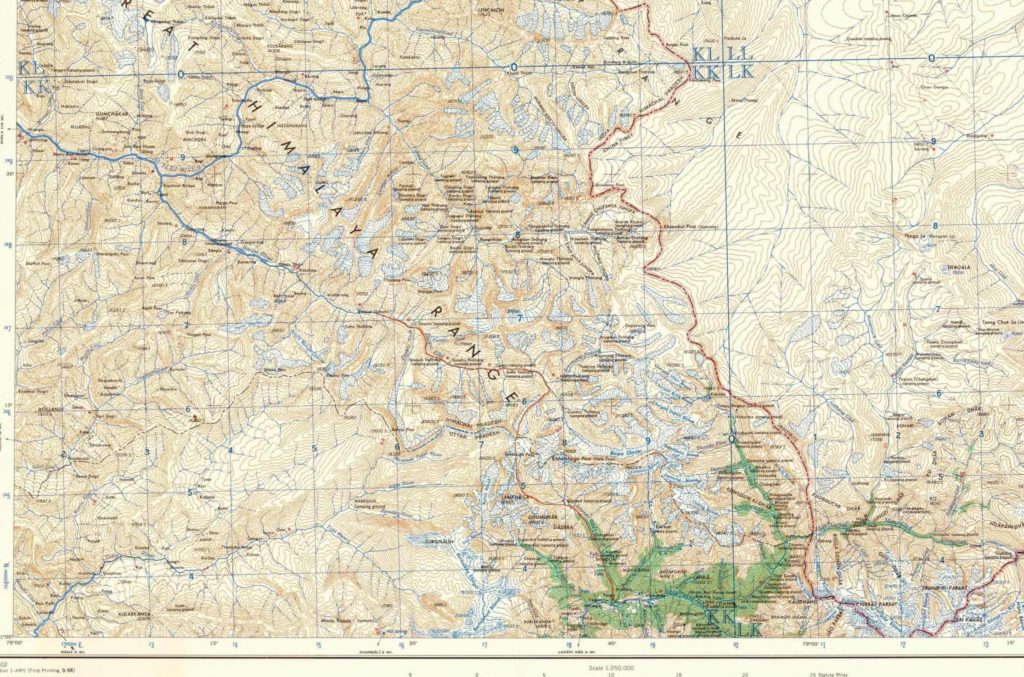

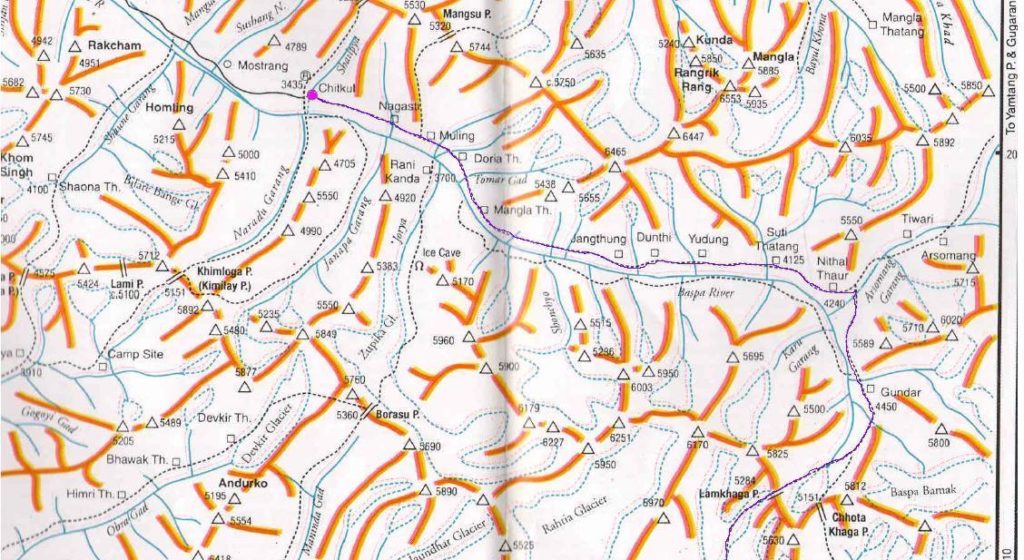
FAQs
Our guides are certified and have been trekking the Himalayas since their school days (all are local guides). They are well equipped and well versed with the terrain, route, the people and local culture.
The guides and porters are adequately trained and skilled in handling emergencies. You will get immediate first aid and all necessary help if required. In case of a medical emergency the porters & guides will carry you to a lower altitude and will contact the rescue authority.
We don’t provide trekking or camping gear or rent.
When it comes to packing for a trek in an efficient way so that you have maximum flexibility with minimum weight, we advise trekkers to pack only what it essentially needed. Packing things that are not required will overburden porters & mules and hamper the probability of competing a high altitude trek like Lamkhaga.
Clothing & Gear
Trekking pants and jackets.
Rainproof pants and jackets.
Thermals underwear.
A pair of gloves.
Short-sleeved trekking shirts.
Long-sleeved trekking shirts.
Woolen cap/ beanies.
Insulating jackets.
Fleece-lined jacket.
Lightweight Sweaters.
Trekking boots.
Flip-flops or river shoes
First Aid.
Sanitary pads/ Tampons.
Toiletries.
Sunscreen.
Hand sanitizer.
Quick-drying towel.
Water Bottle.
Sunglasses.
Chargers.
Headlamp
Many people believe that they need immense physical strength to complete a trek like Lamkhaga, which is not necessarily true. Athletic strength is essential, but mental strength is equally important. Anyone with average physical strength and high mental strength can complete a trek like Lamkhaga pass.
Cardio (aerobic) exercises, like hiking, cycling, swimming, will help you achieve strength before the start of your journey. One crucial thing to remember is that trekking is not a race, so you need to keep up with ample breaks and acclimatization.
The best time to trek Lamkhaga is from May to September (barring the monsoon period). During the spring season (May month), wildflowers, including pink rhododendrons, bloom in the Kyarkoti Valley in Uttarakhand. Clear skies and stable conditions underscore the Lamkhaga pass trek during spring months.
The autumn month of September is renowned for its calming climate and favorable temperatures. Autumn month is a perfect time for night or dawn/dusk photography. Monsoon and winters are usually avoided because of the risks and difficulties presented by Garhwal and Kinnaur Himalayas.
You need to carry the backpack/daypack. The daypack consists of essentials like water, a camera, snacks, and rain gear. The heavy luggage will get carried by a porter.
The key to preventing altitude sickness is to acclimatize properly. In high altitude areas, you should not gain more than 600-800 m of altitude. We advise you to take things easy and not to trek in a hurry.
Regular hydration of at least 5 liters of water a day is a must. Diamox (acetazolamide) is not recommended. Diamox simply tricks the body into breathing faster (by increasing the blood Ph slightly) and in fact avoids symptoms. Acclimatization is the only treatment for high altitude sickness. Take medication only if it is recommended by your doctor.
Throughout the trek, numerous mountain streams of the Baspa Valley & Kyarkoti and the glaciers of Baspa & Jalandhari Gad are the main source of drinking water and cooking water. Mountain stream water & snowmelt water is perfectly safe to drink, although there may be issues with silt mixed water on rainy days. We filter water through the natural sedimentation process. We also recommend that hikers bring a filter fitted water bottle.
The trekking hours are not fixed. The prevailing weather conditions, terrain and walking pace of the group will determine the daily trekking hours. In general, we plan the trek for five to six hours of daily walking on average. In a group trekking expedition, it is essential for us to gauge every individual’s stamina level and plan our journey ahead accordingly. Starting the trek early is key to avoiding the midday heat and arriving at your destination early. This leaves with enough time to rest, acclimatize, and explore the beautiful Baspa and Kyarkoti regions.
There will be toilet tents. Our team digs a hole in the ground and then erects a toilet tent around it for privacy. We brief our guides to erect the toilet tent away from water sources and mountain streams, and on departure the next morning the hole will be filled and covered with dirt. We recommend that you always keep a roll of toilet paper and a hand sanitizer in your daypack.
We have a camp crew who set up the tents and also take care of the cooking and clearing up the trash.
Our trek leader is going to carry a first aid kit. We recommend that you bring a small personal kit of your own to deal with any bruises, scrapes or blisters that you may pick up along the way. The more difficult a trek is, the more exhaustive your personal first aid kit should be.
Generally, it is not required. The water from mountain streams is already purified and much better than the tap water you get in cities. You can carry a filter-fitted water bottle like Lifestraw Go Reusable Personal Filter Water Bottle.
The rule of thumb is to use several thin layers rather than just one or two thick layers. It helps you to peel or strip layers depending on the current weather conditions and the time of day. Use a fabric that soaks moisture away from your skin and dries quickly. Your outer layer should be fully wind and waterproof. We recommend that you wear good quality thermals, woolen socks, and a waterproof jacket. A windproof outer layer is essential to fight wind chills. Choose a thermal base-layer with fabric that sucks sweat away from your skin. You need to cover your hands and feet with high-quality gloves and socks, also a hat to cover your head and a balaclava to shield your face from snowy winds of Lamkhaga snowfields.
If you have no prior experience of walking long stretches on glaciers, you should bring crampons. Crampons fitted trekking boots help you get past the snow with ease(Lamkhaga trek route has a long snowfield stretch). Many people prefer walking on the glaciers without crampons.
You need good quality Gore-Tex boots with a strong grip and sturdy ankle support. Your boots must be fully waterproof and at higher altitudes (like the Lamkhaga base camp) we recommend boots with trekking gaiters to cross the Lamkhaga snowfields.
This is a rather personal preference. Many people swear by them, particularly on treks with long ascents (like Baspa River glacier snout to Lamkhaga pass summit) and descents, others consider that they get in the way and prefer to manage without them. If you have weak hips, knees or ankles, trekking poles can be effective in reducing the strain.
No. We carry good quality 4 season sleeping bags (offering up to -10℃ comfort range), mattresses and pillows.
There is no other way to train for Himalayan altitude than to slowly acclimatize. Our Lamkhaga pass trek itinerary has been carefully planned to allow for gradual acclimatization (at Chitkul and Ranikanda). Altitude sickness can impact the fittest trekkers as easily as the less fit. If you’re on a trek, the main advice is to keep your fluid intake up to stay hydrated. Diamox (acetazolamide) is not recommended. Diamox simply tricks the body into breathing faster (by increasing the blood Ph slightly). It actually covers the symptoms. The best treatment for high altitude sickness is acclimatization or descent to a lower altitude.
During the trek, your luggage is carried by a porter or a mule, and all you need to carry is what you need during the day, such as a bottle of water, camera, extra clothes, sun-cream, and a small personal first aid kit. We recommend a daypack of 15 to 30 liters for Lamkhaga pass trek.
There is no definitive training regime that suits everyone because people have different fitness levels. A workout plan may work great for some and may not work for others. The best way to train for the Lamkhaga trek is to spend plenty of time walking and jogging for at least a month. Aerobic exercise training always helps, but there’s no substitute for simply walking & trotting for several hours at a stretch. It’s also a good opportunity to test out all your trekking gear, clothes and shoes – to make sure everything is comfortable and works well.
It’s not really a problem. You can walk at your own pace almost all the time because we have enough guides to support trekkers of all speeds. Occasionally, for safety reasons, the leader of the trek may pull the group together (e.g., in bad weather or in a difficult section of the trek, including crossing the Nithal Thach stream crossing section and the Lamkhaga base camp to Jalandhari Gad stretch) but in general, the group can string out and everyone finds their own comfortable walking pace.
The evaluation of your personal health is very subjective. Your fitness level is also set against the difficulty level of the trekking route, which includes different factors such as the number of walking hours per day, the total number of days, the duration and complexity of the descent, the terrain, the altitude, and the weather conditions. You need to have previous high altitude trekking experience to match the difficulty level of Lamkhaga. Without being physically and mentally fit, one can not climb Lamkhaga pass or for that matter any pass or a peak.
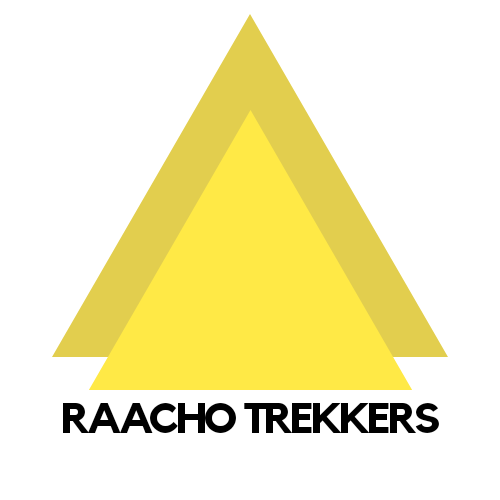
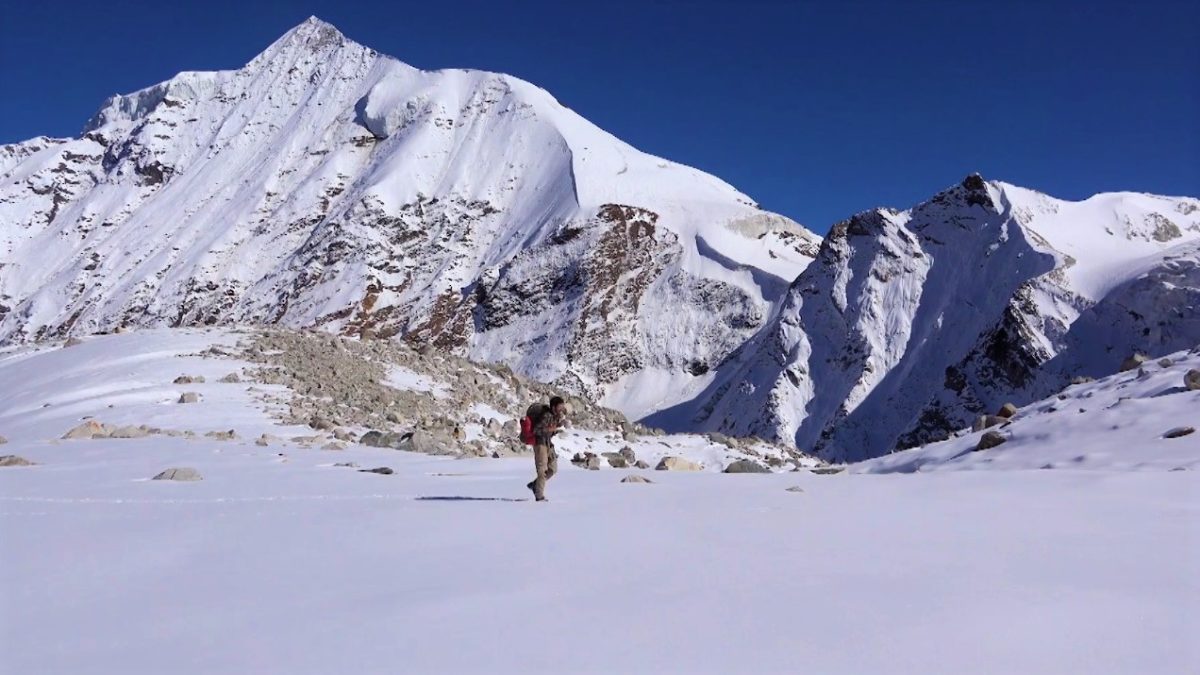
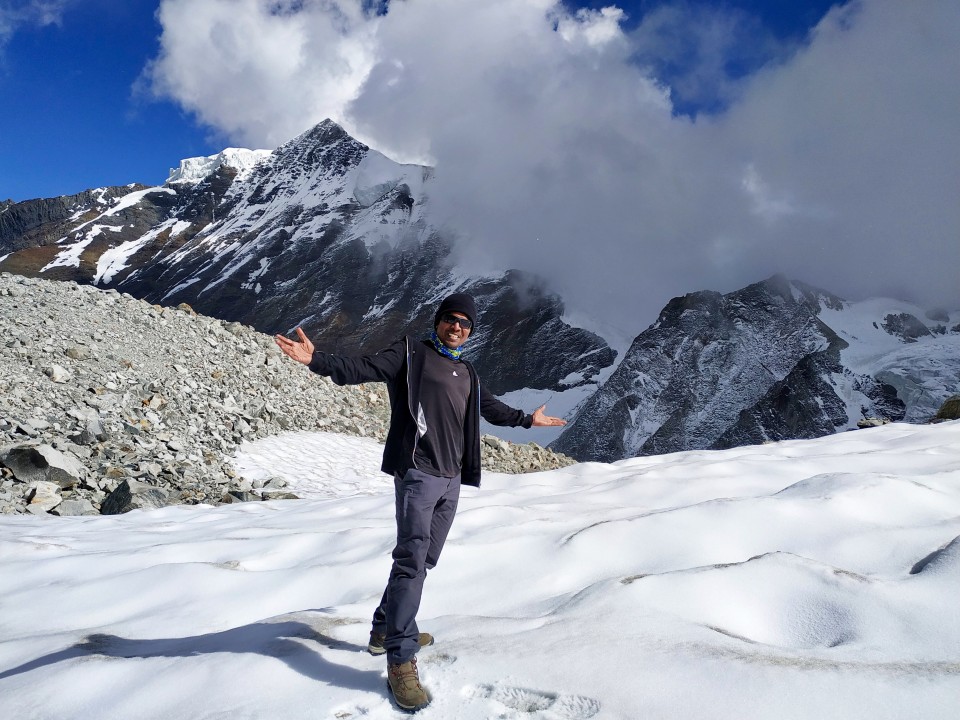








![The traverse The traverse [Lamkhaga pass trek expedition 2015]](https://raachotrekkers.com//wp-content/uploads/2018/03/Lamkhaga-1-147.jpg)
![Near the advance base camp Near the advance base camp [Lamkhaga pass trek expedition 2015]](https://raachotrekkers.com//wp-content/uploads/2018/03/Lamkhaga-1-126.jpg)
![Chotkhaga Pass (left) - Unnamed pass(middle)- Lamkhaga Ridge Pass(Right) Lamkhaga cannot be seen untill you reach its base, its so remote. Chotkhaga Pass (left) - Unnamed pass(middle)- Lamkhaga Ridge Pass(Right) Lamkhaga cannot be seen untill you reach its base, its so remote. [Lamkhaga pass expedition 2015]](https://raachotrekkers.com//wp-content/uploads/2018/03/Lamkhaga-1-124.jpg)
![Baspa glacier snout Baspa glacier snout [Lamkhaga pass expedition 2015]](https://raachotrekkers.com//wp-content/uploads/2018/03/Lamkhaga-1-62-1.jpg)
![And us in the center of Nithal Thach Camp site [Lamkhaga pass trek expedition 2015] And us in the center of Nithal Thach Camp site [Lamkhaga pass trek expedition 2015]](https://raachotrekkers.com//wp-content/uploads/2018/03/Lamkhaga-1-13-2.jpg)
![Night was the only time, when sky used to open up [Lamkhaga pass trek expedition 2015] Night was the only time, when sky used to open up [Lamkhaga pass trek expedition 2015]](https://raachotrekkers.com//wp-content/uploads/2018/03/Lamkhaga-1-73-2.jpg)
![Baspa river, near Ranikanda ITBP post. [Lamkhaga pass trek expedition 2015] Baspa river, near Ranikanda ITBP post. [Lamkhaga pass trek expedition 2015]](https://raachotrekkers.com//wp-content/uploads/2018/03/Lamkhaga-1-54-2.jpg)
![That morning! Ranikanda meadows [Lamkhaga pass trek expedition 2015] That morning! Ranikanda meadows [Lamkhaga pass trek expedition 2015]](https://raachotrekkers.com//wp-content/uploads/2018/03/Lamkhaga-1-54.jpg)

![An evening in Chitkul [Lamkhaga pass trek expedition 2015] An evening in Chitkul [Lamkhaga pass trek expedition 2015]](https://raachotrekkers.com//wp-content/uploads/2018/03/Lamkhaga-1-14.jpg)
Leave a Reply